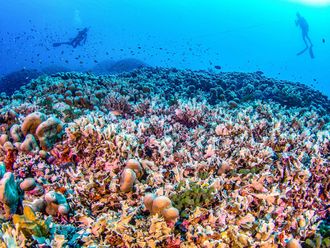Johannesburg: Poachers in Zimbabwe have killed more than 300 elephants and countless other safari animals by cyanide poisoning. The full extent of the carnage in Hwange, the country’s largest national park, has been revealed by legitimate hunters who discovered what conservationists said was the worst single massacre in southern Africa for 25 years.
Pictures obtained exclusively by The Sunday Telegraph show horrific scenes. Parts of the national park, which is visited by thousands of tourists each year, can be seen from the air to be littered with the corpses of elephants, often with their calves dead beside them, as well as those of other animals. There is deep concern that the use of cyanide represents a new and devastating technique in the rapidly growing poaching trade. Zimbabwean authorities said that 90 animals have been killed this way.
But the hunters who captured these photographs said they counted the corpses of more than 300. Poachers killed the elephants over the past three months by planting buckets of water laced with cyanide in the sand. Animals are drawn to them during the dry season in the already arid and remote south-eastern section of the 5,660-square mile park. After the elephants died, often collapsing just a few yards from the source, lions, hyenas and vultures that fed on their carcasses were also struck down, as were other animals such as kudu and buffalo that shared the same water.
Zimbabwe’s authorities claim that the cyanide has been planted by villagers who sell the elephants’ tusks for around £300 each to cross-border traders. They can be resold in South Africa for up to £10,000 a pair, according to court papers relating to one recent incident, sometimes re-emerging as carved artefacts such as bangles in Cape Town’s craft markets.
Zimbabwe has one of Africa’s biggest elephant populations, since herds in neighbouring regions have been severely reduced by poaching.
Half of the country’s estimated 80,000 elephants are thought to live in Hwange. Conservationists say that habitat loss, conflict with humans and poaching means that on current trends the African elephant could die out in the wild within 50 years. In 2011, at least 17,000 of the animals were killed for their tusks according to Cites, the international body that focuses on endangered species.
Ivory is highly prized in Asian countries where a growing middle class is seeking safe investments. The United Nations says the illegal ivory trade has more than doubled since 2007. The poisoning was first uncovered by a European hunter and his Zimbabwean guides who spotted a dead cow and her calf as they flew over the park by helicopter. As they descended they saw scores more. The corpses of endangered white-backed vultures which had fed on the toxic carcasses were dotted near each dead elephant.
“We couldn’t believe our eyes,” one hunter, who did not wish to be named for fear of reprisals from poachers, said. “We thought at first that they must have been shot. There were too many to have died of thirst or hunger.” They flew back to camp and drove into the park after alerting rangers.
“We found that elephants we saw from the air were not shot, but the tusks were gone,” the hunter added. His group spotted a man walking into the park carrying a four-gallon bucket of water and a packet. They watched him dig a hole for the bucket in the sand, lower it in and then mix powder from the packet into the water. Zimbabwe’s National Parks and Wildlife Authority sent investigators and police to the area, where there are normally few patrols.
The water was discovered to contain cyanide which is available cheaply for use in informal local gold mining. After further investigation, police arrested eight men from a village in the Tsholotsho district which borders the park, along with a number of fellow officers who were allegedly bribed to ignore the poachers.
A Harare-based cyanide distributor, to whom more than 45 kg of the poison were traced, was also held. So far, 14 people have been arrested in the case. The Zimbabwean authorities took swift and harsh action, putting captured poachers before the courts where they were jailed for up to 16 years and given heavy fines. Saviour Kasukawere, Zimbabwe’s environment minister, visited a village just outside the park two weeks ago.
She was told that the poachers had acted out of desperation because their crops had failed and tourism fees from hunters and safari operators had dried up. Caroline Washaya-Moyo, a spokesman for Zimbabwe’s National Parks, said 10 more poisoned elephants were found last week, none of which had been dead for more than three weeks, suggesting that the poisoning had not stopped. She said the authorities were struggling to persuade those in custody to identify the organisers. “It is a pity that they all seem so reluctant to identify the big people involved, as ivory, like the rhino horn, is not used in Zimbabwe. It is used by foreigners,” she added. Tom Milliken, of the Elephant and Rhino Traffic network, said he was “astounded” by the scale of the killings. “This is the largest massacre of elephant in this part of the world for the last 25 years,” he added.
Sunday Telegraph, London












